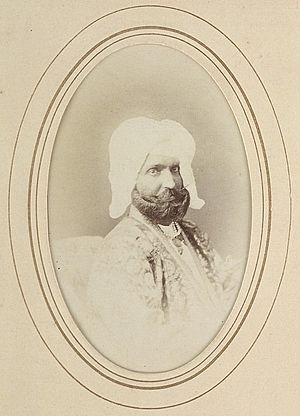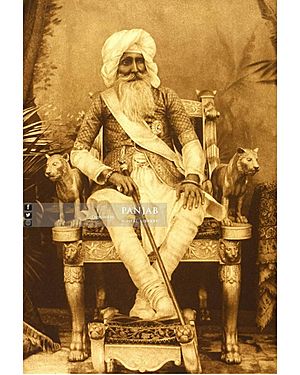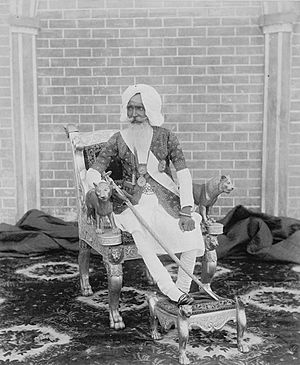Hira Singh Nabha facts for kids
Quick facts for kids Hira Singh |
|
|---|---|
 |
|
| Born | 18 December 1843 Badrukhan, Jind, Gosal (now district Sangrur) |
| Died | 24 December 1911 (age 68) |
| Spouse | Jasmir Kaur |
| Father | Maharaja Sukha Singh Nabha |
Hira Singh (born December 18, 1843 – died December 24, 1911) was an important ruler of Nabha State. Nabha was one of the Phulkian states in the Punjab area of India. He ruled for a long time and helped his state become more modern.
Contents
Early Life of Hira Singh
Hira Singh was born in a place called Badrukhan, in Jind, on December 18, 1843. He was the second son of Sukha Singh, who passed away in 1852. His family was a distant part of the royal Sikh Phulkian family, which also ruled Patiala and Jind. We don't know much about his early childhood.
Becoming the Ruler of Nabha
In 1871, the ruling family of Nabha State came to an end. The young ruler, Bhagwan Singh, died from a sickness. Nabha was a small state that had been ruled by the same family since 1718.
The other two branches of the royal family, from Patiala and Jind, worked with the British government. They chose Hira Singh Gosal to become the new ruler of Nabha.
Hira Singh's Reign and Improvements
Hira Singh became the ruler of Nabha on June 9, 1871. His rule was long and successful, bringing many new things to Nabha. He helped the state become more modern.
He built many important buildings and public places. Roads, railways, hospitals, schools, and palaces were constructed. He also created a strong, modern army. This army helped in wars like the Second Afghan War and the Tirah Expedition.
Farming also got much better during his time. He built an irrigation canal called Sirhind. This helped Nabha grow lots of wheat, sugar, and cotton. Because of this, the state earned more money from its land.
Honors and Recognition
Because of all the improvements Hira Singh made, Nabha State received more respect. In 1877, Nabha was given a higher "salute" of 13 guns. This was a way to show its importance.
Hira Singh himself received special awards. He was given the Empress of India Medal. Two years later, he was made a knight with the GCSI title.
Later Years and Legacy
In 1894, Hira Singh was given the special title of Raja-i-Rajagan. In 1898, his personal salute was increased to 15 guns. He also received an honorary rank of Colonel in the Army.
On January 1, 1903, he was appointed a Knight Grand Commander of the Order of the Indian Empire (GCIE). In 1904, he became a Colonel of the 14th King George's Own Ferozepore Sikhs in the British Indian Army.
Just two weeks before he passed away, Hira Singh was given the highest title: Maharaja of Nabha. He died at his palace, Hira Mahal, on Christmas Eve in 1911. He was 68 years old and had ruled for four decades. His only son, Ripudaman Singh Gosal, became the next ruler.
Family Life
Hira Singh was married four times and had two children, a son and a daughter.
- His third wife, Jasmir Kaur, gave birth to his two children:
- Ripudaman Singh, who later became Maharaja Ripudaman Singh and ruled Nabha from 1911 to 1928.
- Ripudaman Devi, his daughter, who married Ram Singh.
Awards and Honours
Hira Singh received many awards during his lifetime, showing his importance and achievements:
- Prince of Wales gold medal - 1876
- Empress of India Medal - 1877
- Knight Grand Commander of the Order of the Star of India (GCSI) - 1879
- Knight Grand Commander of the Order of the Indian Empire (GCIE) - 1903
- Delhi Durbar gold medal - 1903
- Delhi Durbar gold medal - 1911



